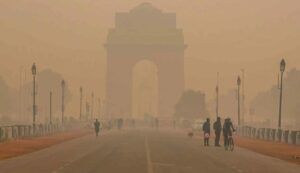
New Delhi: As a thin layer of haze enveloped portions of the city, lowering visibility and causing the air quality index (AQI) to drop to a low level, the national capital’s air quality fell again into the “severe” category on Wednesday morning. The previous two days had seen the air quality index plummet into the “severe plus” category. The Central Pollution Control Board (CPCB) reports that as of 9 am today, the national capital’s Air Quality Index (AQI) was 424, falling into the “severe” category.

In the middle of a blanket of fog, images taken close to India Gate showed individuals going about their regular morning walks and others jogging along the Kartavya Path.
In the meanwhile, trains in Delhi continued to travel despite the fog. A layer of haze covered the region, according to images taken from the New Delhi Railway Station.
According to the Railways, the haze has caused nine trains to be rescheduled and thirteen trains to be operating late.
In areas of the river close to Kalindi Kunj and Okhla Barrage, a heavy coating of poisonous foam continues to float because pollution levels are still high.
Drone footage of the poisonous foam showed the wide-ranging spread of the harmful material-filled froth, emphasizing both its widespread presence and the harm it has done to the local ecology.
According to SAFAR-India (System of Air Quality and Weather Forecasting and Research), as of 9:00 am, the AQI for Anand Vihar was 454, Bawana was 459, CRRI Mathura Road was 392, DTU was 418, Dwarka Sector-8 was 440, ITO was 412, Jahangirpuri was 462, Lodhi Road was 382, Mundka was 465, Narela was 453, North Campus was 421, Punjabi bagh was 446, RK Puram was 425, Shadipur was 421, and Wazirpur was 464.
On Tuesday evening, Delhi Police checked vehicles to make sure Stage IV of the Graded Response Action Plan (GRAP) was being carried out correctly.
With the exception of those used for vital services, Delhi-registered BS-IV and older diesel-powered medium goods trucks (MGVs) and heavy goods vehicles (HGVs) are prohibited from operating under GRAP Stage IV.Due to declining air quality in Delhi-NCR, Stage IV of GRAP has been in place since 8:00 AM on November 18.
In a letter to Union Environment Minister Bhupendra Yadav on Tuesday, Delhi Environment Minister Gopal Rai urged him to call an urgent conference with the Delhi government, IIT Kanpur, and central government agencies including the Ministry of Defense, the Ministry of Home Affairs (MHA), and the DGCA. The purpose of the gathering would be to talk about the urgent need to deploy cloud seeding.
“The time has come to implement artificial rainfall in order to break the smog layer,” Rai said. The Delhi Government investigated cloud seeding as an emergency option to provide rain and lower air pollution at crucial times last year in partnership with IIT Kanpur. We started getting ready for cloud seeding this year in August, but a meeting hasn’t been scheduled yet in spite of several requests.”
He emphasized that in order to successfully reduce pollution, the smog layer has to disperse. Rai went on, “We’re working on this all the time. Both BS-III gasoline four-wheelers and BS-IV diesel vehicles are prohibited. Additionally, all diesel buses and trucks arriving from outside Delhi are prohibited. Class 10 and Class 12 schools have been closed.
The office hours have been changed. We are considering our options and will make a decision shortly on work-from-home policies. Everything that we can is being implemented, and we will keep doing so. The smog layer must be broken.
Since the Air Quality Index (AQI) is still in the “severe” range, the Supreme Court ordered Delhi and the other governments of the National Capital Region (NCR) to rigorously execute GRAP Stage IV anti-pollution measures from Monday.